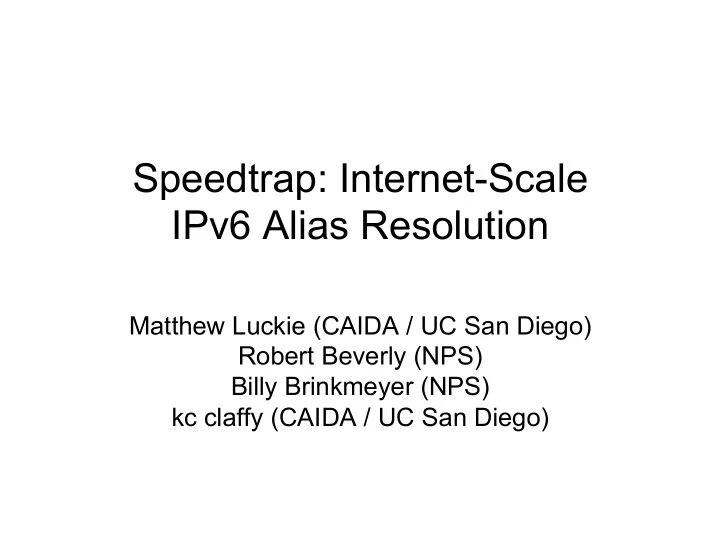

Speedtrap: Internet-Scale IPv6 Alias Resolution Matthew Luckie (CAIDA / UC San Diego) Robert Beverly (NPS) Billy Brinkmeyer (NPS) kc claffy (CAIDA / UC San Diego)
Overview • Alias resolution (IPv4 and IPv6) • Speedtrap: IPv6 • Implementation and analysis • Validation
Alias Resolution • Router-level maps of the Internet are assembled using a set of hacks • Traceroute returns interface IP addresses • Which IP addresses belong to the same router? – Critical step: transforming an IP-interface graph to a router graph
Prior Work (IPv4) • Analytical: – Graph Analysis (Rocketfuel, APAR, etc) – DNS (Rocketfuel) • Fingerprinting – Common source address (Mercator) – Record Route (Discarte) – Pre-specified timestamps (Sherry IMC 2010) – IP-ID (Ally, Radargun, MIDAR)
IP-ID fingerprinting • Ally (Spring et al., 2002) – Obtain sequence of IP-ID values from A and B which suggest a shared counter and therefore aliases Prober A B Probe A x = I D A , = r c , s p l y e R Probe B 1 x + = I D B , = s r c , p l y e R Probe A + 2 x D = I A , c = s r y , p l R e
IP-ID fingerprinting: MIDAR Monotonic Bounds Test (MBT)
Prior Work (IPv6) • Source routing – Waddington, et al. (2003): Atlas – Qian et al. (2010): Route positional method • RFC 5095 (Dec 2007) deprecates source- routing functionality required – Denial of service through traffic amplification • O(N 2 ) probes, comparisons required
Too Big Trick (TBT) • Induce router to send fragmented packets Prober Interface Echo Request, 1300B, seq 0 0 q e s B , 0 0 3 1 , e s o n p s e R h o c E Packet Too Big, MTU=1280 Echo Request, 1300B, seq 1 0 = f O f x , = D I g a F r 1 , q e s , e n s o p s e R o h c E 2 3 2 1 = f f O , = x D g I a r F , 1 q e s e , s n o p s R e o h c E
TBT Effectiveness • March 2013 Interfaces observed by CAIDA ’ s Archipelago • 52,986 interfaces: – 32.1% sent fragments w/ incrementing IP-ID – 17.9% sent fragments w/ random IP-ID – 30.2% did not respond to echo probes – 19.8% did not send fragments
80% of samples occupy 0.00002% of the sample space (<1000) (ID is 2 32 bit value) Shared counter otherwise idle
RFC1981 requires a system to cache MTU for at least 5 minutes recommends 10 minutes. 78% send fragments for at least two hours
High-level Algorithm 1. Determine IPID behaviour of interfaces 2. Solicit non-overlapping sequence 3. Distill candidate routers 4. Pair-wise testing
Implementation scamper: 20pps sc_speedtrap ping ping basic driver: ping measurement logic for resolving result techniques aliases ping result … …
Step 2: non-overlapping sequence • Stage 1: solicit fragmented response from all incrementers • Stage 2: probe all interfaces which overlapped in time in stage 1 • Stage 3: solicit fragmented response from all incrementers
Step 2 stage 2: groups
Step 3: distill candidate routers • Infer candidate routers using a transitive closure (TC) of all interface-pairs that may share counter • Try and cause divergence between A, B: – Probe A, B, A – One second apart • TC groups can be probed in parallel
Step 4: pairwise testing • Final pair-wise testing of candidate interfaces. • In our data, 11,083 of 11,086 interfaces returned sequential IDs
Analysis: Packets and Time Step Packets Time 1 IPID behaviour 317,814 5:35:44 2 Non-overlapping sequence 80,017 1:15:31 3 Distill candidate routers 34,659 1:15:43 4 Pair-wise testing 63,765 1:01:12 Total: 496,255 9:08:10 52,969 interfaces 20pps
17,002 incrementing interfaces 11,181 routers 68%: single interface 21%: two interfaces 11%: > two interfaces Largest: 25 interfaces
Validation • Four sources: – STP-1: RANCID 70 routers – STP-2: DNS 94 (observed) – AP: DNS 267 (observed) – Tier-1: DNS 239 (observed) • Additional networks contacted, but DNS naming schemes were insufficient
Validation Validation name STP-1 STP-2 AP Tier1 Data source RANCID DNS DNS DNS Incrementing IPID 43 40 86 50 Random IPID 43 85 98 No Fragments 11 84 77 No Echo Replies 8 11 Mixed 4 3 Total Routers 70 94 267 239 Interfaces 151/750 85/279 138/1008 79/625 Correct assignments 150/151 85/85 137/138 79/79 451/453 correct assignments. 219 of 11,181 routers (2%)
Future Work • Currently can resolve aliases for 1/3rd of routers – Investigate analytical approach to infer likely aliases • Refine topology mapping process to focus on finding router subnets
Recommend
More recommend